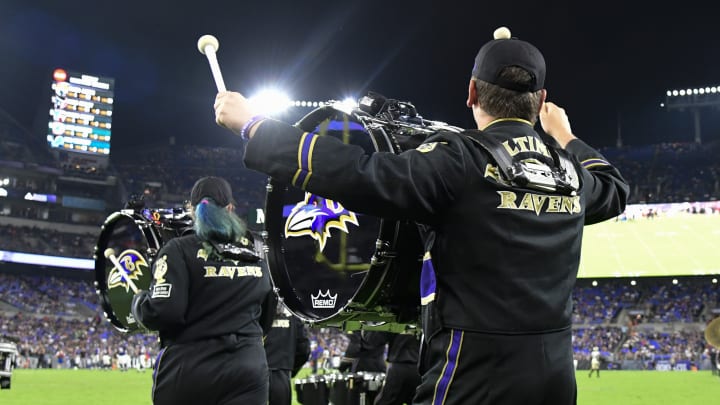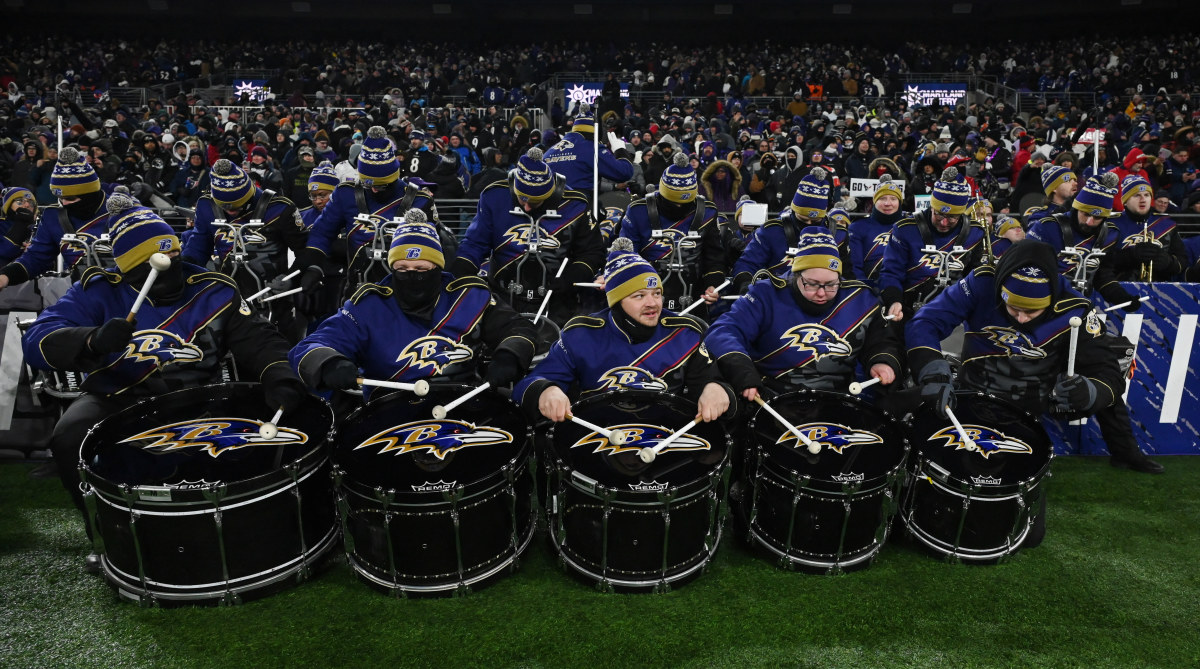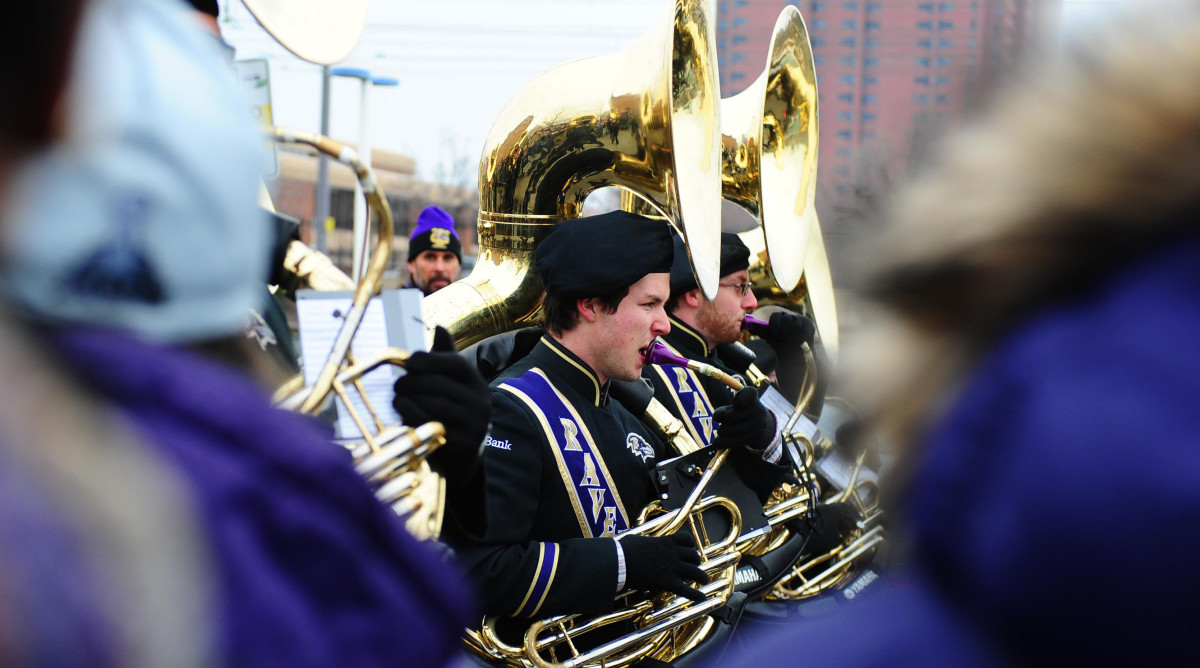The Marching Ravens Helped Make Baltimore a Football Town Again

The first time Baltimoreans embraced a professional football team, their star and centerpiece went by Johnny U. The “U” stood for Unitas, the accidental legend: cut (Steelers), banished (semi-pro football), signed (then Baltimore Colts), forced (into fill-in duty) and, soon enough, three-time league MVP and three-time NFL champion. Through all that, Unitas came to share an affinity with locals who long idolized him.
He came to love the marching band that performed at games, home affairs, mostly, but not always, not with forever-expanding reach. Like other Baltimoreans, Unitas lamented the franchise’s relocation to Indianapolis after the 1983 season. But he welcomed the NFL back, starting in ’96. He’d visit the stadium as often as possible, usually with some combination of his children, including one teenage daughter, Paige. She’s still not sure why, but they always watched from the field, on the sideline. “He was always happy to see the team back,” she says.
Paige Unitas knew others didn’t feel the same way, that they despised the previous owners for yanking pro football and vowed to never again support a team again. But her father’s presence, the obvious ways in which it lifted locals and solidified the Ravens’ standing, all but forced her into fandom. She came to love what he loved, what connected him to them and him to her. The band that started because of professional football but never stopped playing, even when there were no games being played. She knew what all knew: that without this group, now the Marching Ravens, there would be no football Ravens and no NFL, not in Baltimore, period. “They just bring the city together,” she says.
Through everything else—scandals, shutdowns, poverty, urban decay, The Wire and more than one plan to revitalize downtown—the band was there. Always, there. Marching and playing, supporting and advocating, part of a city’s fabric and what separated Baltimore from larger, fancier cities with NFL teams.
Before her father died from a heart attack in 2002, he sometimes asked Paige whether she “wanted to go see the Broadway production.” She didn’t know what he meant at first. But he clarified immediately. He was gently mocking what the NFL had become—slick, packaged, neon, pyrotechnic. He longed for simplicity. He sometimes considered his friend of nearly four decades, John Ziemann, a Marching Ravens lifer, the last person alive connecting then to now. He’s a musician and director and historian who, in Unitas’s view, never stopped fighting the fight that mattered.
Both understood what connects Unitas to Lamar Jackson—beyond Louisville, their shared college stop—what tethers Weeb Ewbank to John Harbaugh and the Colts franchise (Baltimore to Indianapolis) to the Ravens’ version (Cleveland to Baltimore).
It was the same thing that still helps explain a city’s lyrical soul.
It was the second-oldest and single-largest marching band in professional sports. Proof that, in Baltimore, anyway, the U also stands for united.

Ziemann doesn’t simply share the Marching Ravens’ history. He embodies it. He calls immediately after receiving an interview request and soon mails an information packet (clips, brochures, pictures, ranking lists) that’s two inches thick. He calls frequently, offering to answer his phone at any hour on any day that ends in “y.” He doesn’t want this or any story on the Marching Ravens to be only about him. It’s not and … it is. There are others involved—dozens, hundreds, even thousands—but with a slim 77 years of history to their essence, it’s a story best told from the vantage point of one friendship between a marching band J-Z and Johnny U.
“This is my life’s work,” Ziemann says. “It sounds ridiculous, but next to my family, it’s the most important thing.” Part of his family, too. Ziemann met his wife in the band. Had he not—been a member, met her—they wouldn’t have two sons.
After joining in 1962 as a percussionist, Ziemann can recite the history by memory alone: founded (’47), named (The Baltimore Colts Marching Band), played on (without a franchise, through the ’51 and ’52 seasons), became entrenched (from ’53 to ’83), played on once more (until the NFL returned in ’96), renamed (the Marching Ravens). Throughout all of Baltimore’s football machinations, the band was the constant. It played for two franchises and played for no franchise, twice; played in three separate football venues (Baltimore Stadium, Memorial Stadium, M&T Bank Stadium); played through (and wore) at least nine different uniform combinations. For three hours every Wednesday night, members practiced anywhere they could find space, until the franchise offered its Owing Mills, Md., fieldhouse in 2004.
Typically, the Marching Ravens consist of around 130 members and up to 200 total when accounting for staff and the equipment crew beyond musicians. Only one other franchise, Washington, still trots a pep band onto its home field. Members are selected through tryouts held each offseason. Each must try out again each year. The auditions take between six and eight hours and are scored by judges. The criteria, to select the best possible band, never changes. Only talent and musical ability are evaluated. That’s it. To join, aspiring Marching Ravens come from all over, from D.C. and Delaware and Maryland and even further out. All must commit to practice. All must be at least 18, although some have joined in their 60s.
The marchers generally hold around six to eight years of experience playing their chosen instrument; most played in high school, college or military bands. Nearly all hold some form of full-time employment.
A typical Sunday unfolds like this: members gather in the morning, polish instruments, eat and catch up. Then they line up and begin to march, heading outside M&T Bank toward the nearby parking lots, traveling past lines of cars and tailgates stuffed with die-hards who are already imbibing. Their route always finishes in the same place, down what’s called RavensWalk and back into the stadium, where they perform crowd favorites, none more popular than “Raven’s Fight Song” but also tunes like “Seven Nation Army” from The White Stripes. They break, watch and play tunes from the parking lot during timeouts or whenever the home team pulls off big plays. Then they return for the halftime extravaganza, which varies from week to week. Typically, the Marching Ravens play a handful of loosely related songs grouped under the same theme. They continue marching all the while, forming shapes or showing off choreography. After games, they spin back through the parking lots.
Last Sunday, as the Ravens trucked the Houston Texans and the band, as always, played on, Ziemann zoomed right past the statue of his old friend, Johnny U. He smiled, wondering what Unitas “would be saying right now.” Perhaps he’d be surprised that Ziemann is still marching, that he’s probably the only person who works in any capacity for the Ravens who worked for the 1962 Baltimore Colts. He was 14 then, having fudged his application when 15 was the minimum age. He’s not 14 now. He’s the band’s president. Has been for forever.
“Wow,” he thought last Sunday. “I’m old.”
But to be part of what many locals call the Miracle Band? He’d do everything, all over again.
For all the problems that exist in Baltimore, many locals believe their city has been unfairly maligned for far too long. Lost in what they see as stereotyping and lazy, overdramatized descriptions of real issues, they argue, is what ties three related entities—the city, its football team and the marching band for both—together. All seem tethered by that lyrical soul.
Beyond the Marching Ravens, there’s the team name. It’s from a poem, The Raven, by Edgar Allan Poe, who historians say died and was buried in Baltimore. Corporate bigwigs didn’t select this poem, either. Fans did, via focus groups and a poll in a local newspaper, where responders picked “Ravens” four times more often than any other choice.

M&T Bank Stadium was built in the late 1990s atop a site that previously housed a piano factory. A mosaic of keys is featured inside. It sits roughly a mile from the cemetery where Poe is buried. There’s a raven on his headstone. Combine all that with a thriving music scene and even a rock band named the Ravyns that even plays one catchy tune called “(I’m A) Rav’n Maniac.” Lyrics like these hold even deeper meaning.
Been a long time coming
Ain’t gonna lie
Just turn me loose
And let me fly
The football team has hired the band for pep rallies in the past. The team’s success, in seasons like this one, always upticks interest in the song above, which Kyf Brewer wrote.
He’s not the group’s biggest football fan, though. That would be Baltimore native Rob Fahey, who was with the band in California filming a music video when cameras filmed Mayflower moving vans driving away from team headquarters in March 1984, in the middle of the night. Their destination: Indianapolis. What he sees now is a resurgence—for a football team, the city it calls home and the music that bonds both—that took time, for hurt to heal and acceptance to return. When in attendance, he wears Jackson’s No. 8 jersey, while watching the band march into the stadium and marveling at how the Marching Ravens “kept everything together.”
Which is exactly what happened. Ziemann doesn’t want to overstate the band’s impact. So he understates it, saying that, amid the long-ago chaos, no one died, the sun rose the next morning and Baltimore, as always, moved forward. But he also says, “We lost our heart, lost our soul, our pride. “It was like losing a family member, those trucks pulling out, with our history and heritage in them.”
But stop marching? Hell no. Never that. The band never stopped playing; not in 1984, when those vans sped out of town, and not in any subsequent year before the NFL came back in ’96. The band did a lot more than play, though, offering its services to the governor of Maryland, William Schaefer, who charged them with playing on the steps of the Maryland State House in March ’87. Politicians told Ziemann they were four votes short of passing a measure to build a new stadium. When the vote did pass, Schaefer credited the band with providing the winning margin. They didn’t get four votes; they got five.
Guess who helped? Johnny Unitas. When he found out the band kept playing, he called Ziemann and asked what he could do. He backed them, the stadium efforts and, eventually, the new franchise. He appeared on local television, encouraging locals to audition.
“The band was the point everybody rallied around,” Ziemann says.
He drove straight to team headquarters, where, after losing a team, the band gained purpose. It never stopped auditioning, holding tryouts the night after the vans departed. Roughly 175 members continued to do what they did best. They performed at 30 NFL games, 23 college games and one Pro Football Hall of Fame enshrinement ceremony (1991), where the crowd showered the marchers with a standing ovation. Then: at parades, concerts, rallies; oyster roasts and shrimpy boils; and car washes and bake sales. All led to fundraising and the formation of a 501(c)(3).
“Only in Maryland,” one football executive told Ziemann. “Everybody else would have given up. I mean, you lost expansion twice.”
Why keep going? “We were violated,” Ziemann says. “Something was taken away from us, and it didn’t deserve to be. That was our football team. Baltimore’s.”
When Art Modell moved the Browns to Baltimore, he didn’t touch the band, leaving the spirit of pro football in the place where it remained, where it never left. With so much for a relocated franchise to do, they didn’t play at every game immediately. But by that point, the band had already reached high levels of renown, performing for U.S. presidents Harry S. Truman (1950) and John F. Kennedy (’62). They certainly wouldn’t stop now. They celebrated their 50th anniversary in 2007, at halftime of Ravens-Bengals. They performed in a parade the final summer, for the last time as The Baltimore Colts Band.
Members will never forget the date the Marching Ravens—same band, new name, new team, new stadium—made their debut: Aug. 8, 1998. They would play with the Baltimore Symphony, for President George W. Bush, at champions parades (2001), Navy–Notre Dame games (’02) and in the Macy’s Thanksgiving Day Parade (’07), among many other performances. They would be featured in a 30 for 30 documentary titled “The Band That Wouldn’t Die,” which Barry Levinson directed. They would perform in Germany and London (’17), at the Pro Football Hall of Fame game (’18) and at two Hall of Fame induction ceremonies (for Ray Lewis, in ’18; and Ed Reed, in ’19). And the Travel Channel, when compiling a list of 15 Bucket List Experiences football fans needed to complete, would rank watching the Marching Ravens live eighth, ahead of watching any Super Bowl in person.
The band’s current musical director, Dan Fake, first noticed the depth of impact and notoriety and appreciation while in Germany. Fans there not only recognized the Marching Ravens, but they also asked, “Are you coming to London, too?” Indeed, albeit with only 11 members. They wrapped that leg by playing atop a double-decker bus. “This,” Fake says, “becomes part of your identity.” He means for individuals. But he could mean the team instead.
The Marching Ravens even made it into space. One former member, Mark Neuman, played in the now defunct electronic rhythm section, rotating between guitar, bass and drums. He also worked as an engineer at NASA, where he asked an astronaut he knew to carry the Marching Ravens logo on a mission. The astronaut agreed, but NASA nixed the idea at the last minute, owing to a lack of necessary paperwork. But another astronaut, Christina Koch, soon called Neuman and said she would get the forms filled out. She did, and, in March 2019, the logo of the marching band that helped save professional football in Baltimore traveled out of this world, to the International Space Station.
Even players started to take notice. Like kicker Justin Tucker, who warms up near the marchers and will often give them song requests. Others offer compliments, for whatever small ways the band can impact games—and for the large way they tie football in Baltimore together.
The three entities now operate with elite symmetry. The band helped ease the return of professional football to the city. The team wouldn’t exist without it, but the band wouldn’t exist without the team’s endless support under owner Steve Bisciotti, who recently provided another round of new uniforms and new instruments. The city benefits from both, giving locals something to take pride in, especially during seasons as special as this current one.
The combination speaks to what makes Baltimore different from most NFL franchises. There’s no reason to fake community involvement, because it’s already there. The Marching Ravens march all over on what’s called Purple Fridays; in this case, literally drumming up support. Some Ravens fans owe their fandom entirely to the marchers.
“The band is a link between the team and the community,” says Tory Nymick, the team’s manager of entertainment marketing, the department that includes the Marching Ravens. “Especially when we didn’t have a team and how instrumental they were.” She laughs, then adds, “No pun intended.”

Jackie Hamilton’s son, Kyle, stars at safety for the Ravens’ latest Super Bowl contender. He played trombone throughout childhood, and, when she’s asked whether perhaps he might hop into the Marching Ravens’ lineup for a cameo, she says that she has seen the band and always wondered where it came from. Funny she should ask …
When Robert C. Douglass, a journalist turned press secretary to former Maryland Governor William Donald Schaefer, who was just as instrumental in the return pro football to Baltimore, looks at the sport’s fortunes in these specific plays, he believes music, that lyrical soul, played a significant role. Music connected the disgruntled portion of the fan base with the newer portions of Ravens nation. It took the arguments for a new stadium that he was making and allowed anyone listening to hear them, feel them. The fight song united everyone, including Johnny U and the band’s J-Z.
“Nowadays, nobody’s loyal and nobody stays anywhere that long,” Paige Unitas says. “I don’t know a lot about other cities and their football teams, but Baltimore has something special between its players and its fans.”
Ziemann mourned Unitas’s death more than 20 years ago. He thought back to the time his appendix burst, and Johnny U visited him in the hospital. Their friendship started there. The band they both adored helped that friendship blossom. When those politicians asked Ziemann to have the band play on those courthouse steps, the first person he called was Unitas.
Without both, this isn’t a story. The Ravens aren’t playing for another trip to the Super Bowl on Sunday. And the NFL, as a whole, is a little more packaged, a little more static, missing a significant and pivotal piece of its soul. So on Sunday, the Ravens will march into their stadium to play the Chiefs—and the Marching Ravens, as much a part of the city’s sports scene as the football team, will march in alongside them.
